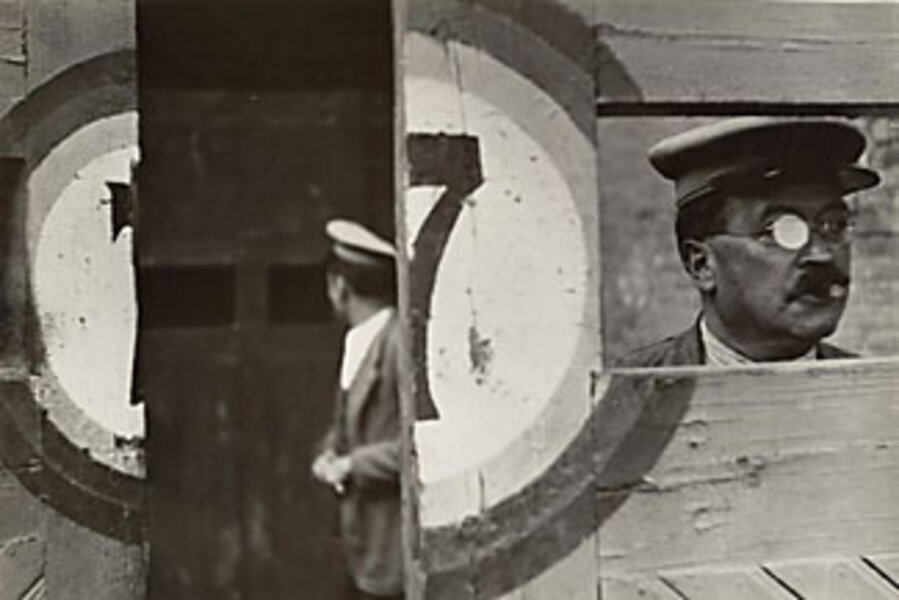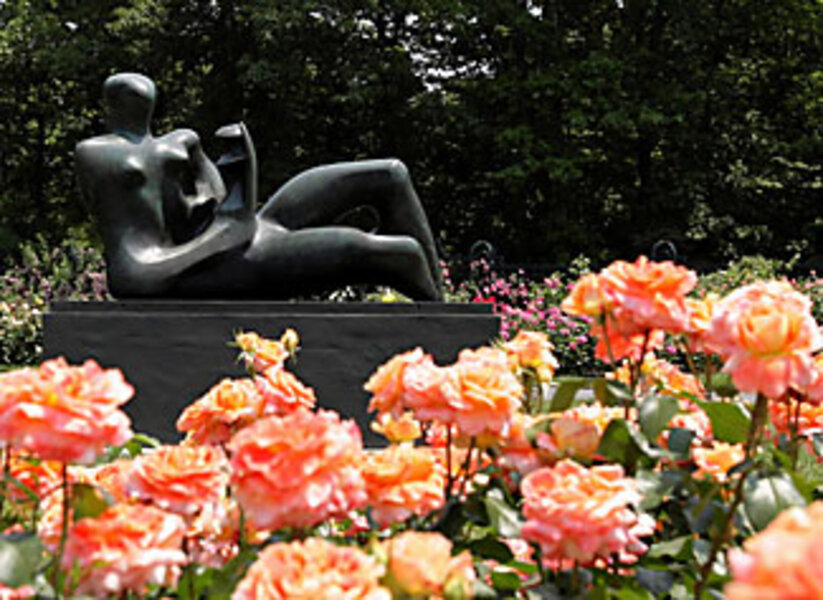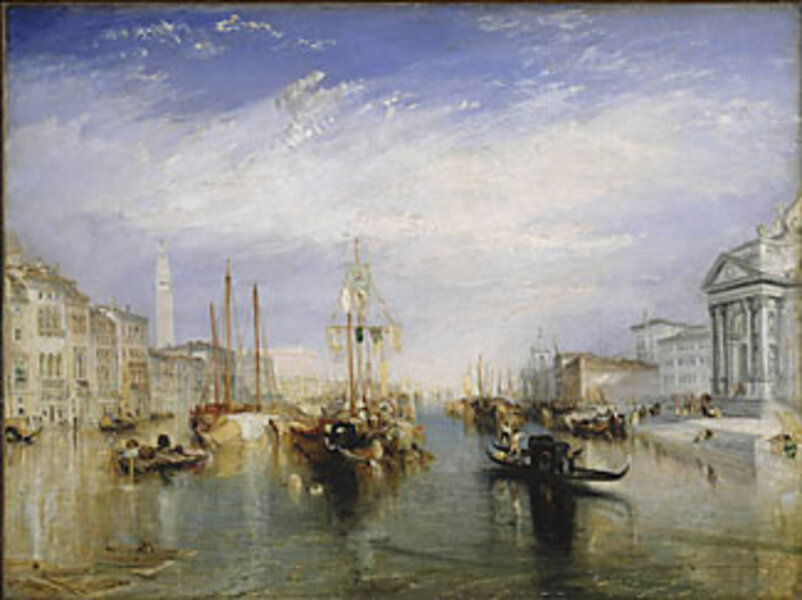The art of summer in NYC
Loading...
| New York
Summer art exhibitions in New York City tend to be crowd-pleasing visual extravaganzas of wide public appeal, akin more to a beach novel than an existential tract. The edgier, more challenging offerings are deferred until fall, when the public is more inclined to ponder than laze. This season's shows are indeed alluring, rivaling the siren call of outdoor activities, but they also radiate an indispensable quality of durable art: originality.
•The Metropolitan Museum of Art hosts two shows by aesthetic pioneers: "Framing a Century: Master Photographers, 1840-1940" (through Sept. 1) and "J.M.W. Turner" (through Sept. 21). The Turner retrospective includes 140 paintings and watercolors, displaying the evolution of this British artist's style over six decades. One sees his early precocity and restless refusal to be confined within the approved genre of history painting.
Born in 1775, Turner developed in an age of political revolution. He set off a revolution himself in paint, as gradually his love of the sublime, awe-inspiring aspects of nature took over his canvases, infusing them with dramatic atmospheric effects. Today, Turner is hailed as a precursor to Impressionism and abstraction. Ironically, the traits we now praise earned him ridicule in his own day. Critics disparaged the "indistinctness" of his style, which was called "crude blotches," "pictures of nothing," and "the contents of a spittoon."
As a critic finally acknowledged in 1906, 55 years after his death, "Turner painted not so much objects he saw as the light which played around them." His landscapes and maritime paintings are a blur of color applied with a palette knife, the subjects almost unrecognizable in a scumble of pigment depicting moonlight, firelight, and blazing sunlight.
•The Met is also showing a dream team of Old Master photographers: 13 early practitioners who invented and perfected the medium. Beginning with the first photographers such as William Henry Fox Talbot, Roger Fenton, and Gustave Le Gray, with about a dozen outstanding prints by each, the exhibition showcases later portrait photographers such as Nadar, Édouard Baldus, and Julia Margaret Cameron, up to modernist, midcentury masters such as Henri Cartier-Bresson and Man Ray. You see each photographer's eye for composition as the art form develops from embryo to maturity.
•The Jewish Museum presents a group of painters who shifted the hub of avant-garde art from Paris to New York in the middle of the last century. "Action/Abstraction: Pollock, de Kooning, and American Art, 1940-1976" (through Sept. 21) highlights the inventors of Abstract Expressionism. All the big names of this golden age of experimentation are here: after Pollock and de Kooning come giants of the New York School such as Rothko, Gorky, and Hans Hofmann. Innovation was king; abstraction reigned supreme. Two critics who explained this radical art to the public are enshrined as its godfathers: Clement Greenberg and Harold Rosenberg.
•Lest we forget sculpture, the Guggen-heim Museum has mounted a full-career retrospective, "Louise Bourgeois" (through Sept. 28). The 96-year-old, French-born, American artist is considered the greatest living sculptor. Her 150 works on view straddle abstraction and figuration, hinting at an emotionally fraught narrative that the viewer must decipher. Bourgeois has written on a drawing, "To forgive in order to forget. I do not want to relive the past. I want to experience the present." Yet her entire body of work deals with her love/hate relationship with her tyrannical father and the conflicting family dynamics of attraction and repulsion. "Art is a guarantee of sanity," Bourgeois stitched on a mailbag in one of her signature "cell" installations. For 70 years, her art has attempted to express what she calls "the tension of being human, the fragility of people." This exhibition is the real thing, art at the highest level of craft that engages the viewer to both feel and think.
•The Whitney Museum of American Art hosts an overview of futuristic designs in its "Buckminster Fuller: Starting with the Universe" (through Sept. 21). Fuller, the inventor of the geodesic dome who died 25 years ago, appears in videos talking lickety-split as he explains his concepts of synergy and sustainability. Fuller's life was dedicated to the belief that a single individual could achieve a maximum benefit for humanity using the fewest resources. Globalism, multitasking, low-carbon footprint, interconnectivity – Fuller was there first with all these concepts.
•For those who can't bear to be indoors, New York City offers two destinations to soak up real sunshine along with art. The New York Botanical Garden in the Bronx has 20 monumental bronze sculptures by Henry Moore scattered among its towering trees and blooming flora. "Moore in America" (through Nov. 2) presents perfectly sited examples of the British sculptor's simplified family groupings. They get a boost from their dialogue with the setting as visitors circle the pieces, touch them, and view their volumes and voids from all angles.
•Until Oct. 13, viewers can also experience "The New York City Waterfalls" at four locations along the East River, conceived by the Danish-Icelandic artist Olafur Eliasson. From Pier 17 at the South Street Seaport in Manhattan or by a boat ride that leaves from Pier 16, one can see all four artificial waterfalls – installed under the Brooklyn Bridge, at Pier 35 near the FDR Drive in Manhattan, on Governors Island, and the Brooklyn Piers. Visible from morning until 10 p.m., the waterfalls suck up water from the river through their 10-story-tall scaffolds of pipes before it tumbles back like a lacy bridal veil. "This is not my work of art," the artist said at a press conference. "It's your work of art. It's part of the city."
Eliasson, known for creating immersive environments that engage the viewer in shared, sensory experiences, hopes the work will be "inclusive rather than exclusive." He opens our eyes to the waterfront and the river so spectators see the space as dynamic, involving, and evolving. The artistic value lies not in its spectacle but in spurring self-reflection. Eliasson's art begins with a "Wow!" but next should come "Whoa!" to make us aware and self-aware, before the "Aha!" of self-revelation.







